Learning Outcomes
After this course, participants will be able to:
- Describe the fitting range and features of the Ponto 3 sound processors.
- Explain how Direct Sound Transmission and INIUM Sense Processing contribute to BrainHearing.
- Describe the importance of output, bandwidth and clarity for BAHS patients.
Introduction and Overview
Today, I will briefly discuss the BrainHearing concept within the bone anchored context. Following that, we will discuss the sound quality aspects of Ponto 3 (output, bandwidth, and clarity). Next, we will discuss the upgrades and changes made with regard to Genie Medical 2016.1 software. Lastly, we will cover improvements in our pediatric focus area, specifically the new Ponto soft band and DSL for bone conduction, and then I will address questions.
When I refer to a Bone Anchored Hearing System, I prefer to use the acronym BAHS. There are other acronyms out there (BAHI, BAHA, BAHD) but for the sake of continuity during this presentation, I will use BAHS.
Ponto 3: The Definition of Power
The Ponto 3 Family of sound processors are the definition of power. In fact, they are the most powerful family of abutment-level sound processors available. With all of the important advances in technology that we're going to discuss today, please remember that our patients and their needs remain our main focus and motivation in bringing new sound processors to the market.
Oticon Medical aims to improve outcomes for BAHS users and we do so from a holistic perspective. We want to focus on how our products can help remove barriers to communication. The greatest challenges for our users are found outside of the clinic, in their everyday lives. That's where we recognize that we have the best opportunity for our sophisticated sound processing to help them overcome these challenges. We also know that all bone anchored users can benefit from more power. As such, we constantly strive in our development to make our products more powerful to deliver those great patient outcomes.
The Ponto 3 is our third generation of Oticon Medical bone anchored sound processors. As its name suggests, it features three sound processors: the Ponto 3, the Ponto 3 Power, and the Ponto 3 SuperPower (Figure 1). The SuperPower device on the far right is the very first abutment-level processor for hearing losses up to 65 dB average BC threshold. The Ponto 3 SuperPower is a single-unit processor in order to deliver that great sound quality and reliability. There's no need for wearing additional elements on the powerful processor.
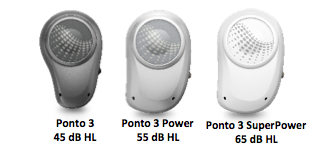
Figure 1. Ponto 3 abutment-level sound processors.
The Ponto 3 Family is based on the new Inium Sense platform, which is also used to power some of the most advanced Oticon hearing aids. In particular, we are proud to introduce the most powerful sound processor ever made that sits on the abutments just like any other bone anchored sound processor. There's no need for wires or body-worn or BTE-worn sound processors, which have been used in competing devices. Just think of the Ponto 3 SuperPower as a normal Ponto sound processor, but with up to 10 dB more output and gain than has ever been possible before. Additionally, being a Ponto, it comes as no surprise that we have better speech understanding as compared to previous devices. It's certainly in our culture of always trying to outdo ourselves with each new product.
Last but not least, we're enormously proud to show our strong commitment to pediatrics with a couple of important innovations. First, in air conduction hearing aids, a large proportion of products that are fit to the pediatric population are done with instruments using the DSL fitting formula. In the field of bone anchored hearing systems, we've now implemented the first ever manufacturer-independent fitting rationale, which is the DSL-BC. Also, coming soon is a new Ponto soft band, to which we have made significant improvements.
BrainHearingTM for BAHS
BrainHearing is about the fundamental understanding of how hearing works and how the brain makes sense of sound. There are four processes of BrainHearing: orient, separate, focus and recognize. First, the brain needs to orient itself to the sounds in the environment. Next, it separates those sounds from one another, in order to then focus in on the important sounds. Finally, based on the listener’s life experience, the brain recognizes and assigns meaning to sounds. In this way, the brain understands what it's listening to.
BrainHearing might be familiar to some of you, especially if you have fit Oticon hearing aids. This concept that was initially introduced by Oticon, but now we bring the BrainHearing methods and thinking to the bone anchored instruments. However, that doesn’t mean that we're simply copying everything as it was originally proposed with conventional AC hearing aids. Bone anchored hearing systems have specific challenges. For example, bone anchored devices naturally have a low maximum output due to the fact that a tiny vibrator has to vibrate the entire skull bone, so all the work has been focused on using the experiences from air conduction the best that we possibly could. We've also been forced to develop new methods to fully deliver on this brain-friendly hearing device in a cosmetically-attractive way.
The first important piece of BrainHearing is focused on Direct Sound Transmission. Direct Sound Transmission refers to the path of the vibrations as they make their way to the cochlea. Specifically, that there is no skin, no tissue, no other obstacles which dampen the sound on its route. This is the way that percutaneous bone anchored implants like Ponto work. The opposite of Direct Sound Transmission would be referred to as skin-drive, which means that there is no direct connection between the vibrating sound source and the skull bone. This would be the case for certain transcutaneous bone connection solutions that exist today.
We have a lot of knowledge about the benefits of Direct Sound Transmission for audibility. However, in order to take the next step and connect Direct Sound Transmission to BrainHearing, it required a new type of test in order to bring that evidence forward. The Sentence Final Word Identification and Recall test (SWIR) is used to measure patient performance on a different level to address the cognitive aspects of speech in noise testing. It was first used in cooperation with Eriksholm Research Center by Lunner and colleagues (2016). Since then, it has been administered with the bone anchored patients here at Kongebakken, with the results published in Ear and Hearing earlier this year.
When administering the SWIR test, first a HINT test is used to find an ecological signal-to-noise ratio (SNR). Since we know that most people in their everyday lives experience a positive signal-to-noise ratio, we want to find an SNR for this testing which provides 95 to 100% intelligibility for each test subject. Next, we verbally present the subjects with a series of seven phonetically-balanced, non-leading sentences. Then we ask them to repeat last word in each of the sentences. They should be able to easily do this task under their optimized signal-to-noise ratio. After that task is completed, the subject is asked to recall as many of those final words as they can. Since we are confident that they have heard and understood all of the words, examining this recall aspect is what allows us to test recall and memory in a new way.
In terms of the physical task setup, the patients wore their sound processor on their abutment, and a second sound processor on a softband adjacent to their abutment (Figure 2). In both cases, softband or abutment, the fittings in both of the devices were optimized for the test. Interestingly, both sound processors were connected to the computer and to Genie Medical, which made it possible to alternately mute and unmute the instruments independently, such that the test person was oblivious to which device was being used at any given time.
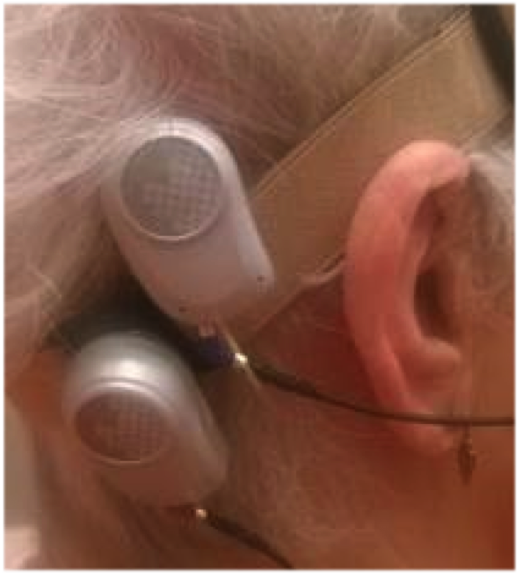
Figure 2. Ponto Plus Power optimally fitted on abutment and softband.
The SWIR test was repeated five times for each condition and both of the conditions were tested in counterbalanced order. The testing itself occurred in the format of free-field testing with the sentences presented at a fixed level, and the noise was varied per individual. It was presented from 180 degrees and 110 degrees, plus and minus from the patient position (Figure 3).
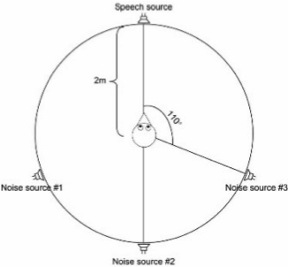
Figure 3. Speaker setup.
They found that the recall is significantly better when the sound processor was attached to the abutment as compared to a softband fitting. That means Direct Sound Transmission provides a 13% improvement of words correctly recalled (Figure 4). In conclusion from those results, Direct Sound Transmission provides more sound to support the brain's cognitive processes, and that's what reduces the effort spent on listening.
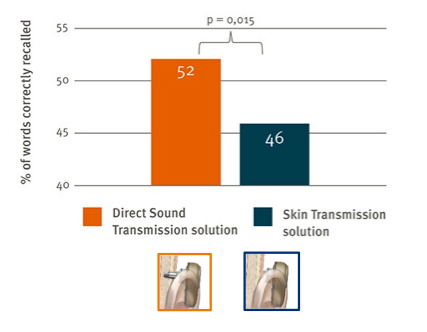
Figure 4. Results summary.
To reiterate, the challenges presented with bone anchored technology (e.g., having to use the tiny device to vibrate the whole skull bone) push us to develop new concepts, in order to deliver devices that will provide excellent brain hearing results for our patients.
Powerful Sound Quality: Output, Bandwidth and Clarity
The other BrainHearing prerequisite entails delivering sound quality to our patients. This is achieved using three parameters that are fundamental in good BrainHearing design for bone anchored hearing systems: output, bandwidth and clarity.
Output involves having enough headroom to reproduce both soft sounds with good audibility and loud sounds without distortion. This might seem to be a basic concept, but the majority of bone anchored patients today have solutions that don't live up to these criteria.
Another element required to deliver quality sound is by providing a wide bandwidth to cover all the important frequencies. Without full bandwidth, listening effort will increase. Even though the patient might still score well on a speech test, they may not be getting the best bandwidth possible. Within the pediatric population, bandwidth is especially important for learning language. Studies have shown that children require three times the amount of listening exposure to learn new words, if they're listening through a reduced bandwidth.
The third parameter is to ensure clarity without distortion, or other artifacts that might confuse the brain, thereby increasing the listening effort. In this particular area, BrainHearing principles led us to use noise reduction methods in new and different ways than have been traditionally used in the past.
Output
The following graph (Figure 5) shows the development of our sound processor output from the very first Ponto (the curve shown in gray), all the way to the Ponto 3 SuperPower, (the curve shown in dark blue). Over the six years since the launch of Ponto, we have managed to increase the power by 14 dB overall. As compared to the Ponto Plus Power (which until the launch of Ponto 3 was the most powerful abutment-level device), the new Ponto 3 SuperPower is up to 10 dB stronger than the previous most powerful device. This is thanks to a unique combination of technologies like vibrator design and a unique step-up output driver for the vibrator itself. It's the same kind of technology that is used in hybrid cars and in LED lights, as well as a very advanced battery management system in the Inium Sense platform. The Ponto 3 SuperPower is unique in that these technologies have never before been used in a bone-anchored system, or even in conventional air conduction hearing aids.
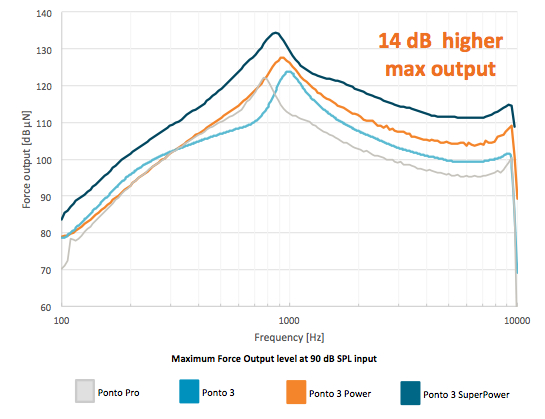
Figure 5. Development of sound processor output.
When we first began talking about Ponto 3 SuperPower, one of the main questions that audiologists had was if there was a risk of over-amplifying patients. The simple answer to that is no. To understand why, we can compare the Max Force Output (MFO) of our devices with other hearing devices.
The following chart (Figure 6) is adapted from Ad Snik's blog. In this case, the information here is some measured MFOs for different sound processors. Even with the power provided by the Ponto 3 SuperPower, the maximum output possible is still more than 20 dB below that of what we'd expect for conventional hearing aids. It's also much below a typical BAHS user's LDL. The only thing that the patient will experience is better sound quality, because of more headroom and less distortion in loud environments and background noise. Those are all elements which are important in reducing listening effort and living up to the BrainHearing principles.
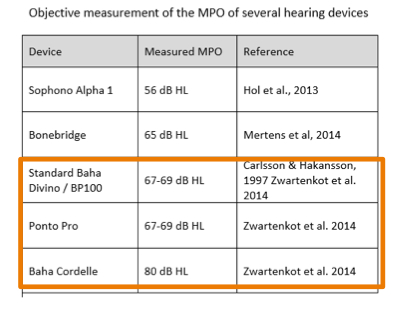
Figure 6. Objective measurement of the MPO of several hearing devices (Adapted from source: www.snikimplants.nl/).
Another way to understand this is to see how it works with conventional air conduction hearing aids. Typically, hearing aid audiologists know that a superpower name on any product is associated with fitting a significant hearing loss, and that it's going to require a lot of amplification. Usually, these devices have high MPO warnings that come in the software. That warning is issued to remind you to take care when you're fitting them, because it is possible to damage hearing with too loud of an AC stimulus.
One question that we often get, is if this warning also applies to bone anchored devices. We do also have a high output, but the MFO is not as close to the LDL as it would be in conventional hearing aids. We use the term “MFO,” since we're talking about the force of vibration and not the pressure of sound waves. However, we do not have the same kind of warning in our software, because bone anchored devices don't have the ability to make the incoming sounds too loud for our users. Even with the SuperPower bone anchored device, the MFO is still well below the LDL. Therefore, by providing a patient with more output, they will receive a wider dynamic range without any risk. Every bone anchored patient can benefit from the higher MFO in Ponto 3 SuperPower.
Another question that we hear often is if patients with conductive losses will get too much amplification. Since their cochleas are working well anyway, wouldn't they get too much amplification if you fit them with a superpower device? Again, the answer is still no, as the gain prescription is following the hearing loss and not the device. When you fit a sound processor, either from an audiogram, or as we recommend, through in situ audiometry, no matter which device you use, the prescribed gain will be equal. Using a superpower device carries no risk and it will provide an increased dynamic range for these patients as well.
Armed with this information, we need to consider what impact the availability of a superpower sound processor has on our candidacy groups. We have three products that fit the classical categories of bone anchored hearing systems – categories that have existed since the 1990s.
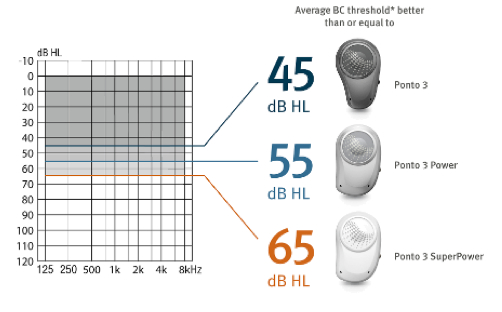
Figure 7. Ponto 3 sound processors and fitting ranges.
We have the regular model (Ponto 3) for hearing losses up to 45 dB HL. Ponto 3 Power is for hearing losses between 45 and 55 dB HL. Finally, the Ponto 3 SuperPower can be used for people with a hearing loss between 55 and 65 dB HL. It’s important to realize that the true need of the users would change this picture significantly. These old limits that were set many years ago, were the result of cosmetics and of practical considerations, rather than audiological needs.
All candidates can benefit from more power. Softband and headband users can benefit, because we would be able to use additional power to compensate for the attenuation through the skin. SSD patients can benefit, to compensate for transcranial attenuation, as well as for up to a mild sensory neural hearing loss in their good ear. Furthermore, those with mixed hearing loss (whose average BC thresholds are beyond 30 dB HL), as well as patients with progressive hearing loss can benefit from Ponto 3 SuperPower. The introduction of Ponto 3 SuperPower is opening up a new paradigm. For the first time, patients can get the power that they need without significantly sacrificing in terms of cosmetics.
Ad Snik from the Netherlands studied the transition from a regular strength sound processor model over to more powerful devices. For many years, Snik documented the consequences of low output in these devices and the criteria difference between patients who used the regular device and those who used the Power model. That difference point is set around 30 dB HL; already at those levels, the more powerful models will give better audiological outcomes. A regular model fitted to the limit of a regular device does not have any headroom to compensate for even a small progression in the patient's hearing loss. As such, there are fewer reasons to focus on having three models, and for fitting the Power model when the SuperPower can cover what the Power does. Since the audiological benefits of the SuperPower model, in terms of sound quality and headroom, are so significant, all patients with hearing losses of 30 dB HL or more should be offered the SuperPower model.
Bandwidth
The next sound quality element is bandwidth. The Ponto 3 sound processors have a bandwidth from 200 Hz to 9500 Hz, which is 38% wider than the bandwidth of other bone anchored devices on the market. It's important to provide the maximum possible bandwidth to our patients, especially in the high frequencies. As cited in the introduction to this section, studies demonstrate the importance of high-frequency inputs, and therefore access to such a wide bandwidth. We want to provide this access as early and as consistently as possible to children who are developing their language every day.
In a study conducted by Andrea Pittman (2008), they set out to determine the learning rate for two groups of children under two different listening conditions. They used a set of five nonsense words and five novel pictures that corresponded to the nonsense words. The words presented were filtered in a couple of different ways. One group of children had the typical 9000 Hz bandwidth, and the other group had a limited 4000 Hz bandwidth. Then the test subjects included children with hearing loss and children with normal hearing. The goal of this research was to find out how many trials were needed in order to be able to correctly pair the word and the picture and learning the words was defined as a 70% correct rate.
Regardless of their hearing status, they found that children who completed the testing under the limited bandwidth condition took on average 75 trials to reach that 70% correct level, as compared to only 25 trials for the children in the extended bandwidth group. In other words, they needed three times as many trials to learn the new words. The study ultimately underscores the importance of providing as much access to high frequency sounds as possible for our language learning patients.
Clarity
The final element of sound quality is clarity. We will discuss clarity as it relates to noise reduction and directional listening capabilities of the Inium Sense chip in the Ponto 3 Family of sound processors.
In today's modern hearing devices, directionality is automatically controlled by systems that sense the listening environment. Based on the listening environment, the device selects the processing strategy that it expects will deliver the best possible speech understanding to the user. For years, such systems have been developed and optimized by engineers to focus on improving hearing the most extreme of listening situations. However, these extreme situations only account for about 5% of listening situations in the daily lives of patients. If you went into the data logging section of Genie Medical, you would likely see a similar pattern of activity for your typical patients as well. They're spending not as much time under a Full Directional setting, but a significant amount of time in Omni Directional or surround setting, or even a Split Directional setting. In order to lower the listening effort and fatigue, the focus should be on the most typical situations, rather than optimizing for the 5% of the time the devices are in Full Directionality mode. The focus should be on the Omni modes where the directional processing is less aggressive, in order to avoid any adverse side effects of Full Directionality. Therefore, in Ponto 3, the improved processing is focused on these Omni modes. It also has a new speech-focused mode, so the user will obtain significant improvement in listening effort and speech understanding.
FreeFocus Test
To build some evidence on selecting the new design of the directionality system, we completed a test (Oticon Medical, 2016) with Ponto users in order to compare the directionality system that we had with Ponto Plus to the FreeFocus directionality system that was proposed for Ponto 3. The purpose of the test was to compare the subjective and objective outcome of the directionality system in Ponto Plus. The test was blind to the patients and the presentation order was randomized. We had 19 adult patients and they were all previous Ponto Plus users. The test material was a Danish language Speech in Noise test (Dantale II), which is similar to the HINT test.
Objective Results
We compared the objective results of patients using Ponto Plus in surround mode, to patients using Ponto 3 in Speech-Focused mode (Figure 8). Subjects using Ponto 3 had a 1.1 dB improved signal-to-noise ratio in the test over when they were using Ponto Plus or Ponto Plus Power. That comes out to approximately 15% improvement in speech intelligibility.
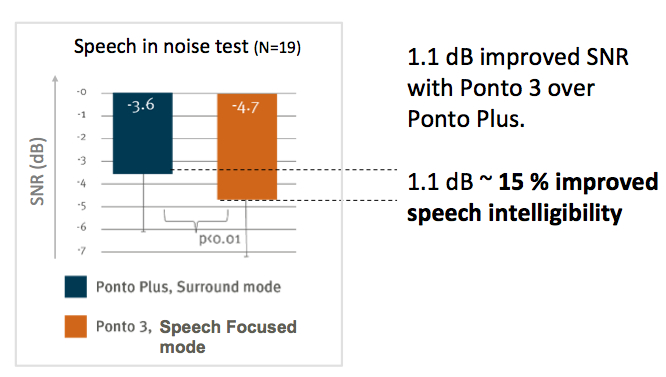
Figure 8. Objective results.
Subjective Results
Beyond the objective results, we also asked for patients’ subjective reactions, which were measured using the Speech Spatial Qualities of Hearing scale (SSQ). On the SSQ questionnaire, patients reported significant improvement in speech understanding and spatial perception with the Ponto 3 settings over the Ponto Plus (Figure 9).
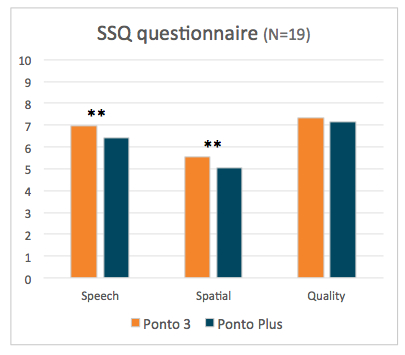
Figure 9. Subjective results.
We also captured some subjective patient reactions:
- “Generally better speech understanding; clearer speech understanding”
- “Hear more clearly what the other passengers in the bus are talking about”
- “I hear better at work (as photographer)”
- “Other people tell me that I hear better, I also feel it myself”
The results of this test were very positive and demonstrated the benefit we could provide to Ponto 3 users: a 15% better speech understanding with the Speech Focused mode in situations that listeners find themselves 70% of the time. By thinking brain first, we were able to capture improvements for more everyday listening situations.
Fitting Ponto 3: New in Genie Medical 2016.1
Alongside all of these excellent results with Ponto 3, we also have made some additions and updates to the Genie Medical 2016.1 fitting software, which allow for an improved audiologist-patient interaction during fitting appointments. The majority of the updates within Genie Medical 2016.1 are found within the Fitting step.
To briefly orient those of you who may not be familiar with this interface, this is a screen shot from the Fitting step (Figure 10). Each of the steps has a similar look and layout. Across the top of the screen, you can see three green and white buttons, indicating each step in the fitting process: Selection, Fitting, and End Fitting.
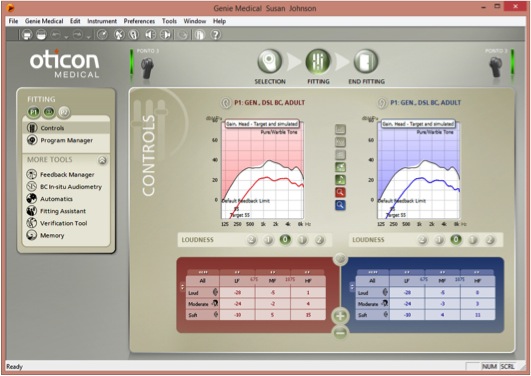
Figure 10. Genie fitting screen shot.
In the Selection step on the far left, you select the instrument, the side, and the type of fitting. For example, if a correction should be made for a softband fitting, or if the patient has SSD, checking a little checkbox would make an automatic adjustment for that fitting type.
In the Fitting step, we recommend that you move down the left side of the menu as you're sitting with the patient. When you land on this screen, you're in the Controls section and can navigate down to Program Manager or a list of tools as necessary.
Finally, the third little circle button at the top is the End Fitting step. Here, you will find more information about accessories, like the ConnectLine system, and you can make changes about the operation of the devices, like enabling and disabling the volume control. You'll also find a summary of the fitting before you save program and exit the software.
Fitting Flow
With the introduction of an even more powerful device, we've made a change to the recommended fitting flow. The new fitting flow is:
1. Direct sound processor
2. Select type of fitting:
- Single-sided deafness
- Softband
3. Measure Feedback limit*
4. Measure BC In-situ*
*The order has been changed from the prior recommended fitting flow: Run the Feedback Manager before BC In-situ.
First, as always, the sound processor should be detected and the type of fitting should be selected. The change we suggest is to run the Feedback Manager prior to measuring the patient's BC In-situ threshold. Previously, the BC In-situ step came first, and then Feedback Manager. The reason we switched these around is that since all fittings you go into with a new patient, they have an assumed or default Feedback limit setting, and that default is used prior to measuring an individual Feedback limit. For example, if a patient's measured Feedback limit is above the default limit, that would mean that the gain prescription calculated following the BC In-situ would be limited by that default Feedback setting. By running the Feedback Manager first, we avoid that situation and provide the patient with as much room as we can in that fitting. Of course, you can still continue with the Fitting flow, the last point being to Hand-out Oticon Medical Streamer, if the patient is using it. As a reminder, you don't have to take any steps to link it to the sound processors. It comes as open and is ready to use out-of-the-box for any patient with the Plus Family or 3 Family sound processors that has wireless capabilities.
Selection Step
The one new aspect of the Selection step is that the Ponto 3 family sound processors are now listed as available devices that can be fit using the software (Figure 11).
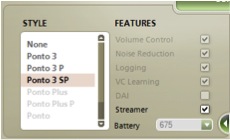
Figure 11. Selecting the Ponto 3 family in the software.
On the Selection step, the Fitting range is shown when the sound processor is selected. Officially, a Fitting range is approved by the authorities and communicated in the product information, and it only addresses the upper limit of the fitting. These published ranges, as you heard today, came from the very first BAHA, but now we've evolved in our understanding.
Since there are fewer reasons to keep the Power model, we focus on the fitting ranges for the conductive patients and for everyone else (Figure 12). The audiological benefits of the SuperPower model, in terms of sound quality and headroom, are so significant that all patients with hearing losses of 30 dB HL or more should be offered the SuperPower model.
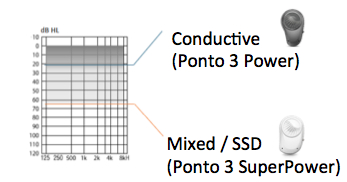
Figure 12. Benefits of higher output.
Fitting
Moving along into the Fitting, one of the first items in the menu is the Program Manager, which controls the addition or deletion of programs. It now has the option to select the Fitting rationale, as is possible with conventional hearing aids (Figure 13). Every Ponto sound processor can be fit using the DSL-BC rationale, whether it's a Pro, a Plus or a 3 family sound processor. In Genie Medical, audiologists can also choose which rationale should be the default. First, navigate to Preferences, Specific Preferences, and then to Default Rationale; then, you have the ability to select the default that you prefer.

Figure 13. DSL-BC fitting rationale is now an option in the software.
FLogram. Genie Medical 2016.1 also introduces FLogram, which is a new way to evaluate and look at the fittings. FLogram is to bone anchored what the SPLogram is to air conduction hearing aids. It is visible for all fittings, meaning that no matter which rationale you have selected or device that you have used, you can see the FLogram. Viewing it does not affect the device prescription; by pressing on FLogram, you aren't making a change to the programming (Figure 14).
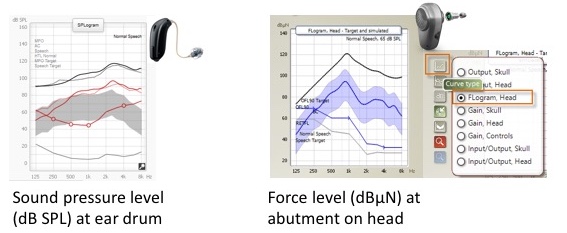
Figure 14. SPLogram for hearing aids (left) and FLogram for bone anchored fittings (right).
FLogram makes it easy for the audiologist to visualize audibility by comparing a few different aspects of the fitting. Figure 15 shows two audiograms and their corresponding FLograms. The patient's measured BC In-situ threshold is the blue line with BC markings at the bottom of the FLogram. The solid black line at the top is the MFO of the device, and the solid blue line is a simulated aided long-term average for your selected signal type that can be adjusted. The shaded area around that solid blue line is the spectrum of that signal.

Figure 15. Two audiograms and their corresponding FLograms (left and right).
RETFL: Reference Equivalent Threshold Force Level. There is a gray curve in the FLogram that is the Reference Equivalent Threshold Force Level (RETFL) for direct bone conduction. It represents the BC thresholds for normal hearing people when measured on an abutment. The given threshold level is 0 dB HL for bone conduction, and it is included for reference. In Figure 15, the RETFL on the left FLogram is covered up by the threshold (since the BC threshold is 0 dB) but you can see the RETFL as the gray line on the right FLogram.
The audiogram on the right has a higher BC threshold of 15 dB HL. You can see that the 15 dB HL BC threshold is accurately represented in the FLogram. You can see the distance from zero and the difference from the RETFL. The RETFL is not representative of normal hearing with softband transmission, because it represents direct bone conduction, so keep this in mind when evaluating a softband fitting using FLogram.
FreeFocus Modes. The FreeFocus modes (that we discussed in the Clarity section) are accessible in the Automatics menu item in the Fitting step (Figure 16). Here, the overall Directionality mode can be selected, as well as the Surround mode specifically, whether you prefer it to be Speech Focused, or Optimized Omni (Opti Omni). Therefore, there are two defaults that are pre-selected on this page. The default Directionality mode is Auto tri-mode (which automatically moves the patients between Surround, Split, and Full as needed). The default Surround mode is Speech Focused, based upon the results of the testing that we did. One might select Optimized Omni for patients who require increased loudness. However, we achieved the strongest results on the Speech Focused Omni Directionality settings, so we chose that one as the default.
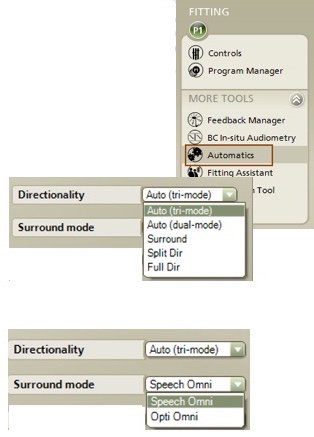
Figure 16. FreeFocus modes.
Binaural Synchronization. Within the same Automatics menu item, when you're doing the binaural fitting, a green button toward the bottom of the page will be enabled that reads “Binaural Broadband On.” This feature is also called Binaural Synchronization. It ensures the directional modes and noise reduction states are synchronized between the left and right sound processors. When it's enabled (which is the default), the hearing instruments will synchronize, so both instruments are in the least aggressive directionality mode. In our example (Figure 17), if a patient's right sound processor is in Split Directionality, but the left sound processor is pulled into Full, it will bring the left sound processor toward the Split directionality on the right.
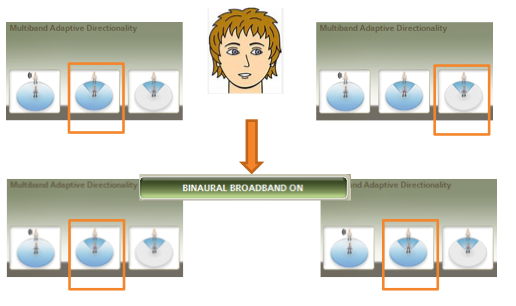
Figure 17. Binaural synchronization.
Binaural Coordination is a feature that allows an action taken on one device (e.g., changing the volume level, changing the program, or muting the sound processor) to be reflected in the opposite device, so that it doesn't need to be repeated. Each of these three tasks can be enabled or disabled individually. This functionality is found in the Buttons and Beeps menu item in the End Fitting step (Figure 18).
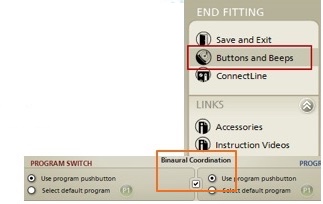
Figure 18. Binaural coordination.
Final Fitting Step. The Final Fitting step news is that we are introducing a Fitting Assistant tool (Figure 19). This will make it easier for audiologists to make fine-tuning adjustments of the sound processor, when necessary. The three dedicated controls are designed specifically to address some of the challenges of BAHS prescriptions and fittings. For all of the trimmers, holding the cursor over a point on the scale will cause a little green box to pop up which will alert you to where the adjustments are specifically made.
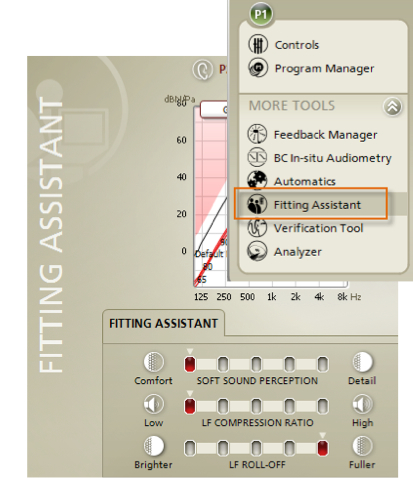
Figure 19. Fitting assistant tool.
The first control is the Soft Sound Perception trimmer. Its default is on the far left-hand side of the scale. Increasing the trimmer will allow for increases in soft level high frequency sounds. The second control is the Low-Frequency (LF) Compression Ratio. Its default is also on the far left. Increasing this trimmer reduces loud and moderate low-frequency sounds. The third control is the Low-frequency Roll-off trimmer, which decreases low-frequency gain at all levels. The default level for LF Roll-off is set all the way to the right-hand side, because we are decreasing LF gain.
Ponto 3: Proven Wireless Connectivity
With its controls also found in the End Fitting step, I did want to remind you to consider the wireless capabilities that continue to be available for a Ponto 3. Ponto 3, like Ponto Plus, also uses the Oticon Medical Streamer to provide users with access to reliable connectivity solutions. On its own, the Streamer provides access to mobile phones, telecoil, streaming music, laptops with Bluetooth connectivity, and it also works as a remote to control the sound processors. You can add ConnectLine accessories for direct streaming from the TV, land line phone, partner microphone, and any Euro pin FM shoe can be connected directly to the Oticon Medical Streamer. The ConnectLine app works with the Oticon Medical Streamer, allowing users to adjust the volume and change program settings from their Smartphone.
Empowering Children: New Softband and DSL-BC
The last section of today's webinar is specifically about empowering our littlest patients, through both physical and technological benefits. As we discussed earlier, sound is the very starting point for language development. It is vital that pediatric users are aided for as much time as possible during their waking hours. Therefore, our development process specified that a newly-designed softband should be able to stand up to high activity levels, be comfortable to wear, and meet our self-imposed safety standards as well.
With the opportunity to return to the drawing board for this development process, we pushed forward on our journey to empower children. Focusing on flexibility for this special group, the new softband will be adjustable in a different way, to eliminate the need for additional plastic buckles, making it much more customizable and comfortable. If the child requires two sound processors, rather than adding more length and an additional hard plastic adjustment piece with a snap on the section of the softband, you simply measure the position for the second processor, and you attach a sound connector to the band in the exact correct position; that sound connector then serves as their second connection plate. We know that only about 10% of all users are bilateral, so therefore many users won't have to use their additional sound connector on their Softband. Instead, these users can use the sound connector and attach it to their favorite hat or cap.
During the development of the sound connector, different solution prototypes were tested where you use a screwdriver-like tool to attach the sound connector; but we did come to the conclusion that since this is a product that will be used by children, the solution should be fully tamperproof and just one-time use. Of course, there's a reassuring click sound when you assemble it, and once it's attached, it's fully tamperproof.
Looking into the different user groups, it's also evident that personalization is a big thing. Some people want the band to be as discreet as possible. But others, especially children, want to wear their favorite bright color. The new softband will come in as many as 14 colors, all from the most neutral to bright green. Five new colors are also introduced for the plastic skins, as well as some beautiful new stickers.
Finally, last section is the DSL-BC fitting rationale. DSL is now tailor-made for and implemented in bone-anchored devices. The rationale was developed by Dr. Bill Hodgetts at the University of Alberta, and Dr. Susan Scollie at the University of Western Ontario. It's not a manufacturer-developed rationale. DSL-BC builds upon the DSL Version 5 concept. It uses the patient's dynamic range as the basis of the prescription. The rationale takes into consideration several aspects, first being the patient's BC In-situ threshold, as well as the MFO of the sound processor, and the Real Head to Coupler Difference, or RHCD, in order to determine the patients' dynamic range. The MFO and RHCD are pieces of product-specific information which are already in Genie Medical, so the audiologist simply runs BC in-situ as usual, and doesn't need to provide any additional input for this prescription. DSL-BC is available in both an adult and a pediatric version, and you will see this reflected in the Program Manager. When you go into the Program Manager, the rationale can be selected in that right-hand box, and the pediatric rationale is, as it is in conventional hearing aids, increased as compared with the adult version.
Drs. Scollie and Hodgetts have also been involved with approving our implementation of it within Genie Medical. During the development, they've written and submitted a paper; we will certainly announce once it is published. It will be particularly interesting for everyone to see the clinical results of the rationale, because its AC counterpart is so well-used and well-loved by pediatric audiologists. Furthermore, as compared to NAL-NL1, which was the only rationale that was available prior to this point, DSL-BC provides less low-frequency amplification, less amplification for pure conductive hearing losses, and some increased amplification for larger mixed hearing losses. Just remember that DSL-BC is available in all Ponto devices, all patients can try it, and we're very proud to offer the flexibility and benefit of this additional fitting rationale for our patients.
Summary and Conclusion
In summary, today we have provided detailed information on the Ponto 3 Family and about the BrainHearing concept for bone-anchored devices. We discussed Ponto 3's powerful sound quality, including the highest output ever from an abutment-level sound processor, the widest frequency bandwidth, and speech understanding improvements. We discussed improvements and changes to Genie Medical 2016.1. Finally, we have demonstrated Oticon Medical's dedication to empowering children through DSL-BC and the Ponto Softband.
With the SuperPower device, our engineers and experts in transducer technology have created a single unit processor for better sound quality and reliability. There's no more need for wearing any additional element on such a powerful sound processor. More power can be beneficial to many people, so the addition of Ponto SuperPower enables you to provide more patients with the best audiological benefits possible.
Questions and Answers
For a four-year-old boy with microtia and atresia in his right ear and a conductive hearing loss who will wear a sound processor on a Softband - is Ponto 3 or Ponto 3 SuperPower recommended?
The Ponto 3 SuperPower is the first abutment-level processor for hearing losses up to 65 dB average bone conduction thresholds. The Ponto 3 SuperPower is a single-unit processor that delivers great sound quality and reliability. There's not any need for wearing an additional element on this powerful processor.
Based upon audiological information, every person using a bone anchored hearing system can benefit from the maximum force output (MFO) of the SuperPower device. The prescribed gain is always based on the hearing loss, not the device. Even with the power provided by Ponto 3 SuperPower, the maximum output possible is still more than 20 dB below that of what we'd expect for conventional hearing aids and well below a typical bone anchored hearing system user's loudness discomfort level (LDL). The patient will experience better sound quality because of a wider dynamic range, more headroom and less distortion in loud environments and in background noise.
If it is a cosmetic concern that you're addressing, then all of the other benefits of Ponto 3 are available in the Ponto 3 (regular strength) sound processor.
At what age can a child transition from the using Ponto 3 on a Softband, to having surgery for a bone anchored hearing system?
The FDA stipulates the age for a surgically-implanted bone anchored hearing system is 5 years and older.
For an adult with single-sided deafness (SSD) of congenital origin who is a candidate for a bone anchored hearing system, which Ponto 3 device is appropriate?
For SSD patients, to take into account transcranial attenuation, the Ponto 3 SuperPower would be recommended.
What battery size is used in the Ponto 3 sound processors?
Ponto 3 uses a size 13 battery. Ponto 3 Power uses a 675 battery. Ponto 3 SuperPower device uses a 675P. It's a more powerful 675 battery that is used in order to drive the UltraDrive technology, this additional transducer technology. 675P batteries should also be available from wherever you currently order your batteries. They are commonly used in cochlear implants.
References
Lunner, T., Rudner, M., Rosenbom, T., Ågren, J. & Ng, E.H.N. (2016). Using speech recall in hearing aid fitting and outcome evaluation under ecological test conditions. Ear & Hearing, 37, 145S- 154S.
Oticon Medical (2016). FreeFocus feature test report, Oticon Medical report no 34425-00.
Pittman, A. (2008) Short-term word-learning rate in children with normal hearing and children with hearing loss in limited and extended high-frequency bandwidths. Journal of Speech, Language and Hearing Research, 5, 785-797.
Further references in course handout.
Citation
Westbrook, J.L. (2017, January). Oticon Medical's Ponto 3 sound processor family: Proven technology to make listening easier. AudiologyOnline, Article 19171. Retrieved from https://www.audiologyonline.com.


